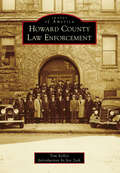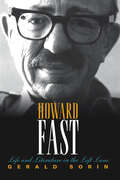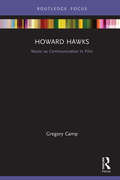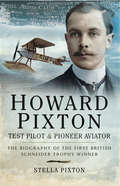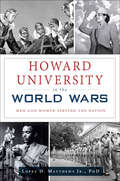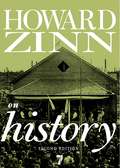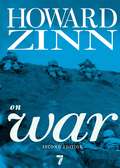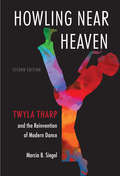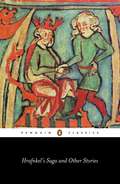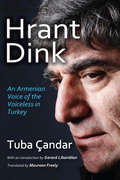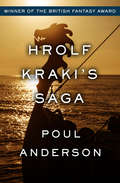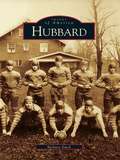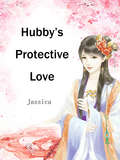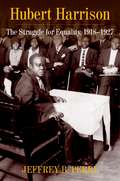- Table View
- List View
Howard County Law Enforcement (Images of America)
by Tom Kelley Jon ZeckSince the 1880s, when a Howard County sheriff's deputy shot the mayor of Kokomo during the commission of a burglary, Howard County law enforcement officers have played an important role in the community's history. Police officers, deputies, and troopers cleared rowdies out of the junction neighborhood, walked downtown beats, rescued tornado survivors, quelled civil disturbances, cleaned up tragic accidents, and solved grisly murders. By the mid-1940s, a new generation of war veterans came home with a spirit of progress and experience in leadership. The foundation of compassion, perseverance, and integrity they established in Howard County law enforcement has defined their unswerving commitment to the safety of the community and to one another. Images of America: Howard County Law Enforcement tells their story.
Howard Fast: Life and Literature in the Left Lane (The\modern Jewish Experience Ser.)
by Gerald SorinHoward Fast's life, from a rough-and-tumble Jewish New York street kid to the rich and famous author of close to 100 books, rivals the Horatio Alger myth. Author of bestsellers such as Citizen Tom Paine, Freedom Road, My Glorious Brothers, and Spartacus, Fast joined the American Communist Party in 1943 and remained a loyal member until 1957, despite being imprisoned for contempt of Congress. Gerald Sorin illuminates the connections among Fast's Jewishness, his writings, and his left-wing politics and explains Fast's attraction to the Party and the reasons he stayed in it as long as he did. Recounting the story of his private and public life with its adventure and risk, love and pain, struggle, failure, and success, Sorin also addresses questions such as the relationship between modern Jewish identity and radical movements, the consequences of political myopia, and the complex interaction of art, popular culture, and politics in 20th-century America.
Howard Hawks: Music as Communication in Film (Filmmakers and Their Soundtracks)
by Gregory CampKnown for creating classic films including His Girl Friday, The Big Sleep, Bringing Up Baby, and Gentlemen Prefer Blondes, Howard Hawks is one of the best-known Hollywood ‘auteurs’, but the important role that music plays in his films has been generally neglected by film critics and scholars. In this concise study, Gregory Camp demonstrates how Hawks' use of music and musical treatment of dialogue articulate the group communication that is central to his films. In five chapters, Camp explores how the notion of 'music' in Hawks' films can be expanded beyond the film score, and the techniques by which Hawks and his collaborators (including actors, screenwriters, composers, and editors) achieve this heightened musicality.
Howard Hughes and the Spruce Goose: The Story of the H-K1 Hercules
by Graham M. SimonsHoward Hughes' life ambition was to make a significant contribution to the field of aviation development. But the monumental folly of his endeavours on the H-KI Hercules meant that he came to be known and remembered to a great extent for all the wrong reasons. The 'Spruce Goose' (a name Hughes detested) became a product of his wild fixation on perfection and scale. Once completed, it was the largest flying machine ever built. Its wingspan of 320 feet remains the largest in history. Yet it only completed one flight; flying for a mile on its maiden voyage above Long Beach Harbour, before being consigned to the history books as a failure.Experienced author Graham M. Simons turns his attention to the production process that saw this colossus take shape. In words and images, all aspects of this process are illustrated. We have shots taken during the initial design period, images of the craft under construction, and photographs taken at the test flights. In addition, Simons has been gifted access to the highly prized and rarely seen aircraft manual produced for the aircraft, content from which has been extracted and used to supplement the narrative.The book goes on to explore the political issues that sprung up as a result of Hughes' endeavours, looking into the Senate War Investigations Committee's findings which explored the extent to which government funds had been utilised in the development and construction of the airship, adding a whole new layer of controversy to the proceedings.
Howard Pixton: Test Pilot & Pioneer Aviator: The Biography of the First British Schneider Trophy Winner
by Stella PixtonThis book is a truly remarkable account that captures the atmosphere, thrills and danger of the pioneering days of aviation. Howard Pixton was flying for A V Roe at Brooklands in 1910 when S F Cody at Laffan's Plain tried to persuade him to join him. But in 1911 he test flew A V Roe's 'tractor biplane, the forerunner of the 504. By now acknowledged as the first professional test pilot, he left A V to join Bristols and for two years demonstrated new models to dignitaries across Europe.In 1913 he joined Tommy Sopwith and in 1914 he became the first Briton in a British plane to win an international race, the coveted Schneider Trophy. This gave Britain air supremacy and Howard was feted as the finest pilot in the World. Sopwith's Tabloid aircraft developed into the 'Pup', and then into the 'Camel'. Throughout The Great War Pixton test flew many of the rapid evolving designs.For a biography of an early aviation pioneer of the top rank, this book cannot be bettered.
Howard Thurman and the Disinherited: A Religious Biography (Library of Religious Biography (LRB))
by Paul HarveyTeacher. Minister. Theologian. Writer. Mystic. Activist. No single label can capture the multiplicity of Howard Thurman&’s life, but his influence is written all over the most significant aspects of the Civil Rights movement. In 1936, he visited Mahatma Gandhi in India and subsequently brought Gandhi&’s concept of nonviolent resistance across the globe to the United States. Later, through his book Jesus and the Disinherited, he foresaw a theology of American liberation based on the life of Jesus as a dispossessed Jew under Roman rule. Paul Harvey&’s biography of Thurman speaks to the manifold ways this mystic theologian and social activist sought to transform the world to better reflect &“that which is God in us,&” despite growing up in the South during the ugliest years of Jim Crow. After founding one of the first intentionally interracial churches in the country—The Church for the Fellowship of All Peoples in San Francisco—he shifted into a mentorship role with Martin Luther King Jr. and other Civil Rights leaders. He advised them to incorporate more inward seeking and rest into their activism, while also thinking of their struggle for racial equality in a more cosmopolitan, universalist manner. Few historical figures represent such diverse parts of the American religious tradition as Howard Thurman did. By telling the story of his religious lives, Paul Harvey gives the reader a window into many of the main currents of twentieth-century American religious expression.
Howard University in the World Wars: Men and Women Serving the Nation (Military)
by Ph.D. Lopez D. Matthews Jr.Despite African Americans' lack of political, social and economic equality in the United States, the students of Howard University answered the call to service in both world wars. Howard supported its men and women in the quest to serve their nation. The university started an army training program during the First World War, and Howard faculty, staff and students pushed the War Department to begin an officer training school for African Americans. The university organized a Reserve Officer Training program in the interwar years, the first at an HBCU. Many of the famed Tuskegee Airmen of World War II were trained first at Howard. Based on a collection of letters sent by Howard students and alumni to the university, historian and archivist Lopez D. Matthews illuminates their wartime experiences.
Howard Zinn on History
by Howard ZinnHoward Zinn began work on his first book for his friends at Seven Stories Press in 1996, a big volume collecting all his shorter writings organized by subject. The themes he chose reflected his lifelong concerns: war, history, law, class, means and ends, and race. Throughout his life Zinn had returned again and again to these subjects, continually probing and questioning yet rarely reversing his convictions or the vision that informed them. The result was The Zinn Reader. Five years later, starting with Howard Zinn on History, updated editions of sections of that mammoth tome were published in inexpensive stand-alone editions. This second edition of Howard Zinn on History brings together twenty-seven short writings on activism, electoral politics, the Holocaust, Marxism, the Iraq War, and the role of the historian, as well as portraits of Eugene Debs, John Reed, and Jack London, effectively showing how Zinn's approach to history evolved over nearly half a century, and at the same time sharing his fundamental thinking that social movements--people getting together for peace and social justice--can change the course of history. That core belief never changed. Chosen by Zinn himself as the shorter writings on history he believed to have enduring value--originally appearing in newspapers like the Boston Globe or the New York Times; in magazines like Z, the New Left, the Progressive, or the Nation; or in his book Failure to Quit--these essays appear here as examples of the kind of passionate engagement he believed all historians, and indeed all citizens of whatever profession, need to have, standing in sharp contrast to the notion of "objective" or "neutral" history espoused by some. "It is time that we scholars begin to earn our keep in this world," he writes in "The Uses of Scholarship." And in "Freedom Schools," about his experiences teaching in Mississippi during the remarkable "Freedom Summer" of 1964, he adds: "Education can, and should, be dangerous."
Howard Zinn on Race
by Howard Zinn Cornel WestHoward Zinn on Race is Zinn's choice of the shorter writings and speeches that best reflect his views on America's most taboo topic. As chairman of the history department at all black women's Spelman College, Zinn was an outspoken supporter of student activists in the nascent civil rights movement. In "The Southern Mystique," he tells of how he was asked to leave Spelman in 1963 after teaching there for seven years. "Behind every one of the national government's moves toward racial equality," writes Zinn in one 1965 essay, "lies the sweat and effort of boycotts, picketing, beatings, sit-ins, and mass demonstrations." He firmly believed that bringing people of different races and nationalities together would create a more compassionate world, where equality is a given and not merely a dream. These writings, which span decades, express Zinn's steadfast belief that the people have the power to change the status quo, if they only work together and embrace the nearly forgotten American tradition of civil disobedience and revolution. In clear, compassionate, and present prose, Zinn gives us his thoughts on the Abolitionists, the march from Selma to Montgomery, John F. Kennedy, picketing, sit-ins, and, finally, the message he wanted to send to New York University students about race in a speech he delivered during the last week of his life.
Howard Zinn on War
by Howard ZinnHoward Zinn began work on his first book for his friends at Seven Stories Press in 1996, a big volume collecting all his shorter writings organized by subject. The themes he chose reflected his lifelong concerns: war, history, law, class, means and ends, and race. Throughout his life Zinn had returned again and again to these subjects, continually probing and questioning yet rarely reversing his convictions or the vision that informed them. The result was The Zinn Reader. Five years later, starting with Howard Zinn on History, updated editions of sections of that mammoth tome were published in inexpensive stand-alone editions. This second edition of Howard Zinn on War is a collection of twenty-six short writings chosen by the author to represent his thinking on a subject that concerned and fascinated him throughout his career. He reflects on the wars against Iraq, the war in Kosovo, the Vietnam War, World War II, and on the meaning of war generally in a world of nations that can't seem to stop destroying each other. These readings appeared first in magazines and newspapers including the Progressive and the Boston Globe, as well as in Zinn's books, Failure to Quit, Vietnam: The Logic of Withdrawal, The Politics of History, and Declarations of Independence. Here we see Zinn's perspective as a World War II veteran and peace activist who lived through the most devastating wars of the twentieth century and questioned every one of them with his combination of integrity and historical acumen. In his essay, "Just and Unjust War," Zinn challenges us to fight for justice "with struggle, but without war." He writes in "After the War (2006) that while governments bring us into war, "their power is dependent on the obedience of the citizenry. When that is withdrawn, governments are helpless." In Howard Zinn on War, his message is clear: "The abolition of war has become not only desirable but absolutely necessary if the planet is to be saved. It is an idea whose time has come."
Howard Zinn's Southern Diary: Sit-ins, Civil Rights, and Black Women's Student Activism
by Robert CohenThe activist and author of A People&’s History of the United States records an in-depth and personal account of the Civil Rights Movement in Atlanta. During the Civil Rights Movement of the 1960s, students of Spelman College, a black liberal arts college for women, were drawn into the historic protests occurring across Atlanta. At the time, Howard Zinn was a history professor at Spelman and served as an adviser to the Student Nonviolent Coordinating Committee. Zinn mentored many of Spelman&’s students fighting for civil rights at the time, including Alice Walker and Marian Wright Edelman. Zinn&’s involvement with the Atlanta student movement and his closeness to Spelman&’s leading activists gave him an insider&’s view of the political and intellectual world of Spelman, Atlanta University, and the SNCC. He recorded his many insights and observations of the time in his Spelman College diary. Robert Cohen presents Zinn&’s diary in full along with a thorough historical overview and helpful contextual notes. It is a fascinating historical document of the free speech, academic freedom, and student rights battles that rocked Spelman and led to Zinn&’s dismissal from the college in 1963 for supporting the student movement.
Howard and the Mummy: Howard Carter and the Search for King Tut's Tomb
by Tracey FernA captivating picture book biography about Howard Carter, the discoverer of King Tut's tomb in 1922.Howard Carter was obsessed with mummies. He met his first when he was a boy in England and lived near a mansion filled with Egyptian artifacts. Howard dreamed of discovering a mummy himself—especially a royal mummy in its tomb, complete with all its treasures. When he was seventeen, he took a job with the Egypt Exploration Fund and was sent to Egypt to learn about archaeology and excavation sites. And his mummy hunt was on! Howard discovered many amazing artifacts, but he searched for years before coming upon the most famous mummy of all, King Tut. With stunning artwork from Boris Kulikov, and an informative and funny text from Tracey Fern, Howard and the Mummy is a true story about the challenges of discovery and the rewards of perseverance.
Howell's Storm: New York City's Official Rainmaker and the 1950 Drought
by Jim LeekeMore than half a century ago, New York City felt the increasing effects of drought, which lasted throughout 1949 and into 1950. By February, the desperate city had to try something different. Mayor William O'Dwyer hired a municipal rainmaker. Dr. Wallace E. Howell was an inspired choice. The handsome, 35-year-old Harvard-educated meteorologist was the ideal scientist—soft-spoken, modest and articulate. No fast-talking prairie huckster, he took credit for nothing he couldn't prove with sound empirical data. Howell's meticulous nature often baffled jaded New Yorkers. Over the next year, his leadership of a small ground and air armada, and his unprecedented scientific campaign to replenish the city's Catskills reservoirs, captured the imagination of the world. New York's cloud-seeding and rainmaking efforts would remain the stuff of legends—and controversy—for decades.This is the first in-depth look at New York City's only official rainmaker—an unintentional celebrity, dedicated scientist and climate entrepreneur, whose activities stirred up controversy among government officials, meteorologists, theologians, farmers and resort owners alike.
Howling Near Heaven: Twyla Tharp and the Reinvention of Modern Dance
by Marcia B. SiegelFor more than five decades, Twyla Tharp has been a phenomenon in American dance, a choreographer who not only broke the rules but refused to repeat her own successes. Tharp has made movies, television specials, and nearly one hundred riveting dance works. Her dance show Movin’ Out ran on Broadway for three years and won Tharp a Tony award for Best Choreography. Howling Near Heaven is the only in-depth study of Twyla Tharp’s unique, restless creativity. This second edition features a new forward that brings the account of Tharp’s work up to date and discusses how dance and dance-making in the United States have changed in recent years. This is the story of a choreographer who refused to be pigeonholed and the dancers who accompanied her as she sped across the frontiers of dance.
Howling at the Moon: The Odyssey of a Monstrous Music Mogul in an Age of Excess
by Walter Yetnikoff David RitzShow biz memoir at its name-dropping, bridge-burning, profane best: the music industry&’s most outspoken, outrageous, and phenomenally successful executive delivers a rollicking memoir of pop music&’s heyday.During the 1970s and '80s the music business was dominated by a few major labels and artists such as Michael Jackson, Bruce Springsteen, the Rolling Stones, Bob Dylan, Billy Joel, Paul Simon, Barbra Streisand and James Taylor. They were all under contract to CBS Records, making it the most successful label of the era. And, as the company&’s president, Walter Yetnikoff was the ruling monarch. He was also the most flamboyant, volatile and controversial personality to emerge from an industry and era defined by sex, drugs and debauchery. Having risen from working-class Brooklyn and the legal department of CBS, Yetnikoff, who freely admitted to being tone deaf, was an unlikely label head. But he had an uncanny knack for fostering talent and intimidating rivals with his appalling behavior—usually fueled by an explosive combination of cocaine and alcohol. His tantrums, appetite for mind-altering substances and sexual exploits were legendary. In Japan to meet the Sony executives who acquired CBS during his tenure, Walter was assigned a minder who confined him to a hotel room. True to form, Walter raided the minibar, got blasted and, seeing no other means of escape, opened a hotel window and vented his rage by literally howling at the moon. In Howling at the Moon, Yetnikoff traces his journey as he climbed the corporate mountain, danced on its summit and crashed and burned. We see how Walter became the father-confessor to Michael Jackson as the King of Pop reconstructed his face and agonized over his image while constructing Thriller (and how, after it won seven Grammies, Jackson made the preposterous demand that Walter take producer Quincy Jones&’s name off the album); we see Walter, in maniacal pursuit of a contract, chase the Rolling Stones around the world and nearly come to blows with Mick Jagger in the process; we get the tale of how Walter and Marvin Gaye—fresh from the success of &“Sexual Healing&”—share the same woman, and of how Walter bonds with Bob Dylan because of their mutual Jewishness. At the same time we witness Yetnikoff&’s clashes with Barry Diller, David Geffen, Tommy Mottola, Allen Grubman and a host of others. Seemingly, the more Yetnikoff feeds his cravings for power, sex, liquor and cocaine, the more profitable CBS becomes—from $485 million to well over $2 billion—until he finally succumbs, ironically, not to substances, but to a corporate coup. Reflecting on the sinister cycle that left his career in tatters and CBS flush with cash, Yetnikoff emerges with a hunger for redemption and a new reverence for his working-class Brooklyn roots.Ruthlessly candid, uproariously hilarious and compulsively readable, Howling at the Moon is a blistering You&’ll Never Eat Lunch in this Town Again of the music industry.
Hrafnkel's Saga and Other Icelandic Stories
by AnonymousWritten around the thirteenth century AD by Icelandic monks, the seven tales collected here offer a combination of pagan elements tightly woven into the pattern of Christian ethics. They take as their subjects figures who are heroic, but do not fit into the mould of traditional heroes. Some stories concern characters in Iceland - among them Hrafknel's Saga, in which a poor man's son is murdered by his powerful neighbour, and Thorstein the Staff-Struck, which describes an ageing warrior's struggle to settle into a peaceful rural community. Others focus on the adventures of Icelanders abroad, including the compelling Audun's Story, which depicts a farmhand's pilgrimage to Rome. These fascinating tales deal with powerful human emotions, suffering and dignity at a time of profound transition, when traditional ideals were gradually yielding to a more peaceful pastoral lifestyle.
Hrafnkel's Saga and Other Icelandic Stories
by Hermann PalssonTHE stories in this volume date from the thirteenth century, the Golden Age of saga writing,
Hrant Dink: An Armenian Voice of the Voiceless in Turkey
by Tuba CandarThis is the biography of Hrant Dink, a Turkish-Armenian journalist and political activist. He worked for the democratic rights of all Turkish citizens, including the right to speak freely about the genocide of Anatolia's Armenians in 1915. As a result of his activism, Dink was assassinated by Turkish nationalists in 2007.As founder and editor-in-chief of the bilingual Turkish-Armenian newspaper, Agos, in 1996, Dink was the first secular voice of Turkey's silenced Christian-Armenian minority. He fought for the democratization of the Turkish political system. This was a risky undertaking, in a country where Armenians live as closed communities; it was also unprecedented in Turkey. Dink was prosecuted three times for "insulting and denigrating Turkishness" and ultimately convicted.The biography is written as an oral history, and assembles a mosaic of memories as told by Dink's family, friends, and comrades. Dink's own "voice," in the form of his writings, is also included. Originally published in Turkey, it is now available for an English-speaking audience on the 100th anniversary of the Armenian genocide.
Hrolf Kraki's Saga
by Poul AndersonA tale of battles, betrayals, revenge, magic, and monsters: The ancient legend of the fabled sixth-century Danish king, retold by an acclaimed master of science fiction and fantasy In the court of the Anglo-Saxon king, a visiting storyteller regales the assembled nobles with the enthralling tale of her faraway land's most revered hero: the Viking Hrolf Kraki. Born of an incestuous union into a royal family with a history of violence, jealousy, usurpation, and murder, Hrolf assembled a loyal band of the mightiest champions in the realm and expanded his small kingdom through wisdom, courage, and conquest. Unbeaten on the battlefield, his great deeds and victories became legends throughout the North as he ushered in an era of peace and prosperity. But Hrolf's desire for vengeance was ever the warrior-king's driving force, as he sought the truth about his father's murder. This obsession would threaten Hrolf's life and his rule--and ultimately bring his great kingdom to ruin. Poul Anderson, one of the acknowledged giants of twentieth-century fantasy and science fiction, employs his unparalleled storytelling talents to bring Denmark's most thrilling ancient legend to life. A tale that predates the stories of King Arthur and his knights and Shakespeare's Hamlet, while echoing the Oedipus and Beowulf myths, the saga of Hrolf Kraki, the greatest of all Danish Viking kings, takes on a new and breathtaking richness in this classic novel that was honored with a British Fantasy Award in 1974.
Huawei: Leadership, Culture, and Connectivity
by Tian Tao David De Cremer Wu ChunboThe inspirational business story of Huawei: how to grow from start up to world leader in two decades… With over 170,000 employees in more than 170 countries and regions, serving more than one-third of the world′s population, how does entrepreneur Ren Zhengfei manage a telcoms giant called Huawei? What is the secret to Huawei’s global success? In 1987, a 44-year-old man founded a telecom equipment-trading firm in Shenzhen, China, with start-up capital of $5,000. In 29 years, it grew to become the largest telecoms company in the world. This book goes behind the scenes to explore the story of what Ren Zhengfei did differently, how the company he started reached the top spot, and why Huawei is known as a "collective" and not a private company: Learn how this Chinese start up business became an international success Understand the business strategy, leadership skills and management philosophy of Huawei’s entrepreneurial founder Get tips, inspiration and motivation for your own business start-up. 14 years of meticulous research and 136 senior management and employee interviews reveal how Huawei′s international business success lies in its ability to transform the intellectual elite into a band of soldiers with the same set of values and resolve, while at the same time preventing a culture of subservience. This fascinating story provides a unique glimpse into the machinations of one of the world’s most powerful companies. "The company serves as an example for many Chinese entrepreneurs striving to go global, and also presents valuable lessons for Western companies striving to integrate Eastern and Western values and ways of looking at business." - Co-author David De Cremer, KPMG Professor of Management Studies at Cambridge Judge Business School
Hub-and-Spoke Cartels: Why They Form, How They Operate, and How to Prosecute Them
by Joseph E. Harrington Luke Garrod Matthew OlczakThe first comprehensive economic and legal analysis of hub-and-spoke cartels, with detailed case studies.A cartel forms when competitors conspire to limit competition through coordinated actions. Most cartels are composed exclusively of firms that would otherwise be in competition, but in a hub-and-spoke cartel, those competitors (&“spokes&”) conspire with the assistance of an upstream supplier or a downstream buyer (&“hub&”). This book provides the first comprehensive economic and legal analysis of hub-and-spoke cartels, explaining their formation and how they operate to create and sustain a collusive environment. Sixteen detailed case studies, including cases brought against toy manufacturer Hasbro and the Apple ebook case, illustrate the economic framework and legal strategies discussed. The authors identify three types of hub-and-spoke cartels: when an upstream firm facilitates downstream firms to coordinate on higher prices; when a downstream intermediary facilitates upstream suppliers to coordinate on higher prices; and when a downstream firm facilitates upstream suppliers to exclude a downstream rival. They devote a chapter to each type, discussing the formation, coordination, enforcement, efficacy, and prosecution of these cartels, and consider general lessons that can be drawn from the case studies. Finally, they present strategies for prosecuting hub-and-spoke collusion. The book is written to be accessible to both economists and lawyers, and is intended for both scholars and practitioners.
Hubbard
by Barbara EmchHubbard traces its heritage to the historic Connecticut Western Reserve and is the living legacy of Nehemiah Hubbard Jr., a member of the Connecticut Land Company who purchased 15,274 acres and hired Samuel Tylee, Hubbard's first settler, as his land agent to measure and sell lots. Hubbard remained a quiet farming community untilthe coal-mining boom of the early 1860s changed its future forever. Immigrants from Europe flocked here to work in the mines, and the industrialization of this small town began in earnest. Prosperity continued until the decline of the region's steel industry in the 1970s and, later, the loss of several major businesses. Along with the new millennium,however, came the formation of the Joint Economic Development District between Hubbard City and Township, which brought much-needed development to the Interstate 80, State Route 7/U.S. 62 corridor.
Hubby’s Protective Love: Volume 1 (Volume 1 #1)
by JassicaAs a daughter of the Gu family, Gu Yun didn't love his father, nor did his mother. She had thought that her life would be passed down in such a mundane manner. Her father would assign her to an ordinary family, and she would be taught a lesson and spend her life in peace. Who would have thought that Imperial Tutor Xiao's playful words would allow Gu Yunchao to be chosen by his gyrfalcon as the Imperial Tutor's wife? After poking a hornet's nest, who didn't know that Grand Tutor Xiao was the lover of Gu Yun's elder sister? Gu Yun had never argued, but he felt that it was unnecessary. However, if he bullied her and tried to steal her man and harm her life, he would never back down or compromise in the slightest!
Hubby’s Protective Love: Volume 2 (Volume 2 #2)
by JassicaAs a daughter of the Gu family, Gu Yun didn't love his father, nor did his mother. She had thought that her life would be passed down in such a mundane manner. Her father would assign her to an ordinary family, and she would be taught a lesson and spend her life in peace. Who would have thought that Imperial Tutor Xiao's playful words would allow Gu Yunchao to be chosen by his gyrfalcon as the Imperial Tutor's wife? After poking a hornet's nest, who didn't know that Grand Tutor Xiao was the lover of Gu Yun's elder sister? Gu Yun had never argued, but he felt that it was unnecessary. However, if he bullied her and tried to steal her man and harm her life, he would never back down or compromise in the slightest!
Hubert Harrison: The Struggle for Equality, 1918–1927
by Jeffrey B PerryThe St. Croix–born, Harlem-based Hubert Harrison (1883–1927) was a brilliant writer, orator, educator, critic, and activist who combined class consciousness and anti-white-supremacist race consciousness into a potent political radicalism. Harrison’s ideas profoundly influenced “New Negro” militants, including A. Philip Randolph and Marcus Garvey, and his work is a key link in the two great strands of the Civil Rights/Black Liberation struggle: the labor- and civil-rights movement associated with Randolph and Martin Luther King Jr. and the race and nationalist movement associated with Garvey and Malcolm X.In this second volume of his acclaimed biography, Jeffrey B. Perry traces the final decade of Harrison’s life, from 1918 to 1927. Perry details Harrison’s literary and political activities, foregrounding his efforts against white supremacy and for racial consciousness and unity in struggles for equality and radical social change. The book explores Harrison’s role in the militant New Negro Movement and the International Colored Unity League, as well as his prolific work as a writer, educator, and editor of the New Negro and the Negro World. Perry examines Harrison’s interactions with major figures such as Garvey, Randolph, J. A. Rogers, Arthur Schomburg, and other prominent individuals and organizations as he agitated, educated, and organized for democracy and equality from a race-conscious, radical internationalist perspective. This magisterial biography demonstrates how Harrison’s life and work continue to offer profound insights on race, class, religion, immigration, war, democracy, and social change in America.
